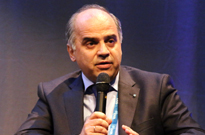
编者按:EASL2017期间,希腊雅典国立Kapodistrian大学、Laiko综合医院消化科George Papatheodoridis教授在会上发表了题为“HBV-related HCC risk and oral therapy: point of no return?”的演讲。《国际肝病》前方记者现场采访到Papatheodoridis教授,请他介绍HBV相关HCC的预防与治疗进展。
预测:HCC风险评分的预测性有差异
慢性乙型肝炎(CHB)患者发生肝细胞肝癌(HCC)的最重要危险因素是年龄和疾病严重程度。对于已经发展为肝硬化的患者,尤为重要。
部分亚洲HCC风险评分将HBV DNA水平与其他标志物一起纳入,但似乎不适用于高加索人患者。Papatheodoridis教授认为,可能是因为欧洲患者通常能较早获得治疗,或是启动治疗后可快速降低HBV DNA水平。而许多亚洲患者HBV DNA水平特别高,需要较长时间才能降低HBV DNA水平。目前尚不能确切知道不同HCC风险评分之间存在预测差异的原因。
然而,基于白种人的风险预测评分似乎适用于亚洲患者,一篇来自台湾的文章显示了其在中国大陆和台湾患者中的较好预测性。所以目前不完全确定为什么亚洲HCC风险评分不适用于高加索人患者,尽管这是欧洲至少两项不同大型研究的发现结果。
预防:近期只能寄希望于抗病毒治疗
除抗病毒治疗外,目前没有其他治疗有望降低CHB患者的HCC风险。据Papatheodoridis教授介绍,在Ⅱ期临床研究早期发现了较新的药物,但进展缓慢,所以不久的将来未必会有新的疗法可以降低CHB患者的HCC发生风险。
抗纤维化治疗在乙型肝炎中并不发挥作用,目前所使用的抗病毒治疗本身具有抗纤维化效果,因为一旦病毒复制停止,纤维化就有所改善。研究表明,患者经过五年抗病毒治疗后,如果FibroScan检测结果较低,则无发生HCC的风险。FibroScan的低结果是由于抗病毒治疗,故对于CHB患者,需要进行抗病毒治疗,但不需要抗纤维化治疗。
对于存在持续致病因素的患者,进行抗纤维化治疗有益。如果不能去除引起肝损伤的致病因素,就需要进行抗纤维化治疗。
治疗:新药Ⅲ期临床试验进行时
Papatheodoridis教授指出,临床试验中发现有几种药物可以治疗HCC,而不是预防。nivolumab(PD-1抑制剂)和另一种药物目前在进行Ⅲ期临床试验,尚需时日,但Ⅱ期研究结果显示有效。
继靶向治疗在癌症(如黑色素瘤)的成功应用后,目前仍不能确定肝脏中的靶点。在nivolumab的Ⅱ期临床试验中,确定了肝细胞中的PD-1受体,但是药物的作用与受体的存在无关。很奇怪,这种药物在肝脏中是如何发挥作用的,但至少Ⅱ期临床试验结果显示是有希望的。希望Ⅲ期临床试验结果能给我们答案。
附加风险:糖尿病和代谢综合征
糖尿病和NAFLD无疑是HCC发生的附加危险因素。如果我们可以通过降低肝脏疾病的严重程度、消灭HBV DNA以及抑制病毒复制来降低基础风险,那么炎症减轻、无新肝损伤,如此肝纤维化得以缓解、肝功能得以改善。
经过几年的单纯抗病毒治疗,患者的HCC基础风险会有所下降,您可能会认为来自糖尿病和NAFLD的附加风险不太重要。但实际上,如果基线年度风险为5%,那么对于合并糖尿病的患者而言,该风险将增加5.5%~10%。如果抗病毒治疗后,患者HCC发生风险低于1%,那么之后风险增加10%也就没那么重要了。总之,基础风险较高时,这些辅助因素显得尤为重要。
英文原文:
The strongest risk factors are probably age and disease severity. For patients who have already developed cirrhosis, this is a very strong risk factor. HBV DNA and other markers are included in several Asian scores. These don’t seem to work very well in Caucasian patients, probably because we tend to treat those patients a little earlier or we decrease HBV DNA very shortly after treatment initiation. In Asia, there are many patients with very high HBV DNA levels and it takes time for the HBV DNA to decrease. But we are not entirely sure why we find differences between the predictability of the different HCC risk scores. It does appear that the scores developed with Caucasian patients do work in Asian patients. There is a paper from Taiwan showing that predictability is very good in Taiwanese patients and in Chinese patients as well. So I am not entirely sure why the Asian scores do not work very well in Caucasians, but this has been the finding in at least two different large studies in Europe.
For the near future, I don’t know of any other treatment that would decrease HCC risk. There are newer drugs in early phase II trials, but development is usually slow, so I would not expect any new therapies in the near future. Antifibrotic therapies will not work in hepatitis B. The antiviral therapy we currently have will themselves have an antifibrotic effect because there is an improvement in fibrosis once virus replication is stopped. Studies have shown that patients after five years of therapy, who have a low FibroScan result, have no risk for cancer. The FibroScan results are due to the antiviral therapy, so an antifibrotic would not be necessary. Antifibrotic therapies are good for diseases where there is a persistent causative factor. If you cannot stop the cause of the liver injury, then antifibrotics would be needed. In hepatitis B, you need antiviral therapy, not antifibrotic therapy.
For patients who have already developed HCC (rather than for prevention), there are a couple of agents in clinical trials. Nivolumab, the PD-1 inhibitor, and another agent are in phase III trials and will take time, but the phase II results are promising. After the successes with targeted therapies in cancers like melanoma, we are still unsure of the target in the liver. In the phase II studies with nivolumab, they identified PD-1 receptors in the liver cells, but the effect of the drug was independent of the presence of receptors. So it is strange how that drug works in the liver, but in the phase II trials at least, the results were promising. We have to wait to see the phase III results, but for now we don’t know for sure.
Diabetes and NAFLD are certainly additional risk factors. If we can decrease the baseline risk by reducing the severity of the liver disease and removing HBV DNA and stopping virus replication, there will be a decrease in inflammation and no new liver damage, so that fibrosis improves and liver function improves. After a few years of antiviral therapy alone, the basic risk for patients is reduced and you could argue that the additional risk from diabetes and NAFLD is less important. If there is a 5% annual risk at baseline, then that risk increases by 10% to 5.5% with diabetes as a complication. If the HCC risk is below 1% after antiviral therapy, the consequent 10% increase in risk is proportionately not very important. These cofactors are more important when there is a high risk.